Every grower’s goal is to increase their cannabis plants’ overall yield, which is why there are numerous different plant training techniques for marijuana.
One of many growers’ more common techniques is manifolding. This article will discuss:
- What manifolding is
- The benefits of manifolding cannabis
- And the step-by-step process of applying manifolding to your plants.
We also answer frequently asked questions about manifolding such as, ‘When is the best time to start?’ and ‘Is it possible to manifold clones?’.
Our guide to manifolding cannabis:
Download my Grow Bible to start growing like a pro by learning how to manifolding marijuana and get great yields.
Grow Bible

- Grow with my Quick Start Guide
- Discover secrets to Big Yields
- Avoid common grow mistakes
Error: Contact form not found.
What is manifolding?
Manifolding is a plant training technique that encourages your marijuana to grow multiple bud sites.
The process involves creating a cannabis manifold, which is a type of branch structure produced by topping your plants multiple times.
The term manifold in cannabis means that all of the branches come from a single point at the base of the plant, while topping refers to the pruning method you apply to encourage lateral growth.
Topping is closely tied to manifolding because it’s a necessary step to create the unique branch arrangement that this plant training method is known for.
Topping involves removing the apical bud of your cannabis plants, which is the topmost growth.

Doing so diverts the growth hormones into the lateral branches, which will turn into your plant’s new main branches.
When manifolding, you need to repeat this step at least 2-3 times to get the best results, which is where many of the concerns about manifolding arise.
As we know, cannabis can react negatively to pruning and get stressed since pruning involves removing precious plant matter that they may need to survive.
However, your plants will bounce back stronger after being pruned more often than not – as long as you know where and when to start.
With manifold and other plant training methods, you must choose both robust and healthy plants since sickly ones will have a much harder time recovering from the stress of pruning.
So the question is, should you manifold your cannabis plants?
Yes. Although it does stress your plants, it’s a type of stress that will encourage them to grow multiple bud sites and grow more vigorously.
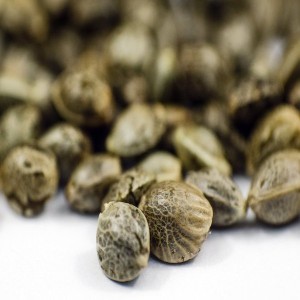
Buy Outdoor Marijuana Seeds
- Easy to grow
- Guaranteed germination
- Beginner friendly
- Grow guide available
Can you manifold autoflowers?
Although it is possible to manifold autoflowers, we do not recommend it. Manifolding requires two important factors, one of which is time.
All high-stress plant training methods need a recovery period, something that autoflower strains – known for their short grow time – don’t have room for.
The other important factor in manifolding is choosing healthy and robust plants. While autoflowers do handle sudden shifts in temperature well, the same can’t be said when topping them.
Most autoflowers can’t handle the stress of pruning; often, it causes them to flower prematurely as a response.
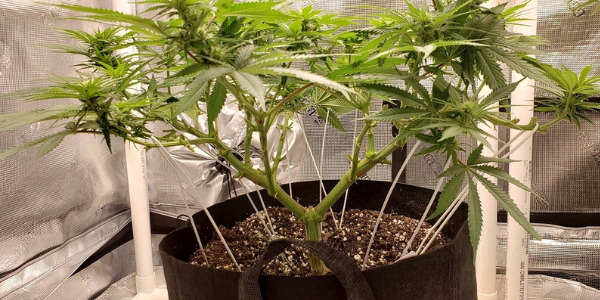
If you choose to manifold your autoflowers, your window of when you can top your autoflowers without overstressing them is small.
Still, you can make it easier by selecting autos with longer grow times, such as Amnesia Haze, AK-47, and Blueberry autoflower.
But if you truly want a faster grow that you can also manifold, the better alternative is using clones.
The only concern with manifolding clones is that they have asymmetrical nodes, which means you end up with one side having more instead of getting equal numbers of branches.
However, clones can handle stress much better than autos. You can even trick them into having a longer veg period to give them time to recover.
What’s needed to manifold your cannabis plants
There are two things that you need before you manifold your plants. The first is good grow lights.
Small LEDs and fluorescent lights won’t do since they’re not strong enough to penetrate and give your plants the light they need.
Choose metal halide; high-pressure sodium grow lights, or a light-emitting ceramic setup (LEC) instead.
The second is space. When you manifold your plants, you spread out the main branches so that they can get equal amounts of light and also avoid overcrowding.
For this, you would need a lot of room in your indoor garden.
The best types of cannabis for manifolding cannabis
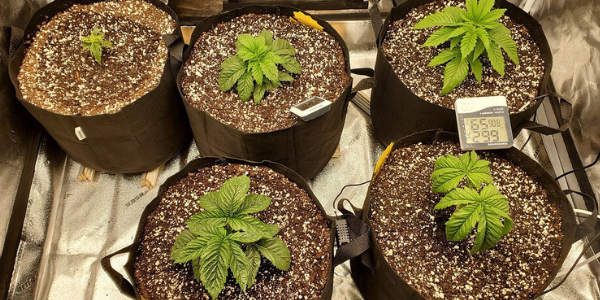
For seed plants
The best type of weed strain for manifolding are ones that produce robust and vigorous plants.
You would want robust plants to ensure that they can bounce back from the stress of being manifolded.
The same goes for why you would want vigorous plants. The stronger the strain, the higher chance that it will bounce back from being topped multiple times.
Additionally, it helps to choose strains with overall strong genetics that help your plants resist common stress-related conditions such as hermaphroditism and avoid mutations such as foxtailing.]
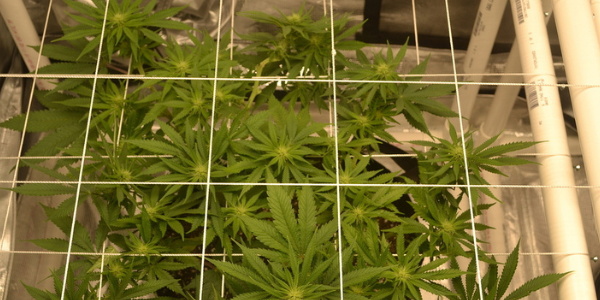
For clones
The best clones for manifolding are the same as how you would choose the best type of cannabis seed.
Factors such as how robust the plant is and how vigorous it grows are essential to consider when selecting a clone.
Another thing to consider is the node symmetry of your clones since, unlike plants from seeds, clones grow asymmetrical nodes.
As your cannabis plant grows, its branches lose their symmetry, and since clones come from the branches of adult plants, the asymmetry carries over.
Equipment & supplies for manifolding cannabis
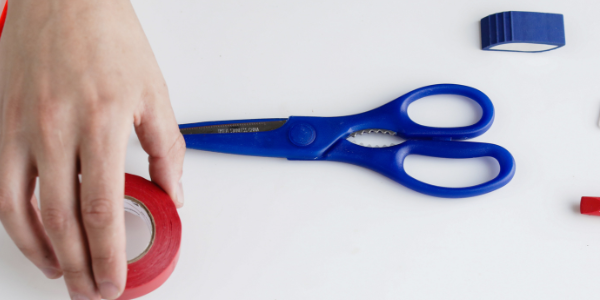
Pruning scissors
One of the tools you’ll use a lot in this process is pruning scissors. You’ll use them to top your plants to manifold them.
Soft ties
To get the manifold shape you want for your plants, you will need to tie down the branches of your plant by using soft garden ties.
Grafting tape
Grafting tape comes in handy when you accidentally prune a part of your plant that you weren’t supposed to. It can help glue the two pieces back together.
Training pot
A training pot is any grow pot that has holes on the rim. If you don’t have any stakes, these holes act as an alternative anchor point for your garden ties.
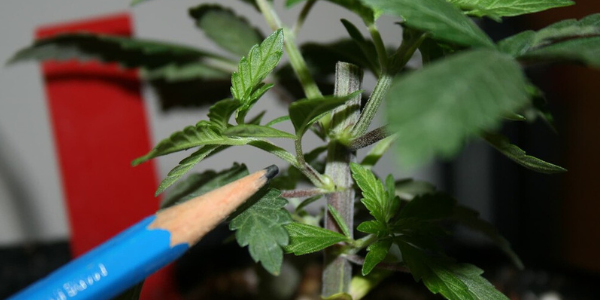
When should you start manifolding?
The best time to manifold your plants is once they have developed 5-6 nodes.
This way, you can ensure that your plants recover quickly from being topped. If you topped your plants too early, you could potentially stunt their growth instead.
Another reason why you would need to wait until your marijuana plants have sufficient nodes is so you’re left with enough leaves.
When topping your plants to create a manifold, you would have to remove its topmost growths, which is everything starting from the 3rd node.
Additionally, waiting until your plant has grown enough nodes guarantees that the remaining branches develop enough to become new main stems once topped.
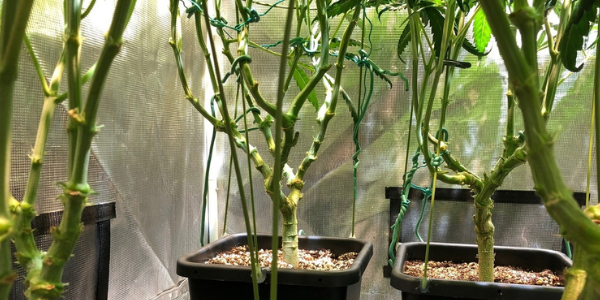
How to manifold cannabis
Manifolding is a tedious and repetitive process, some of which you may miss or do at the wrong time. Here is how to manifold your plants properly.
Step 1: Topping
To start the process of manifolding, you will need to top your plants. But before that, you need to ensure that your plants have at least 5-6 nodes before you top them.
You want to have enough branches after you top your plants since effective topping requires you to remove the topmost growth of your plant starting from the 3rd node.
Step 2: Training
After topping your plants, tie down the main branches with the soft garden ties.
You can either use stakes as anchors or, if you’re using a training pot, secure the ties to the holes you see on the rim.
Step 3: Topping (again) defoliation and pruning
Once the two branches of your cannabis plant have turned into the new main stems, top them again.
After topping, remove any of the unnecessary growths through defoliation and pruning. An example of unnecessary growths are the foliages under the manifold and large fan leaves.
Step 4: Flowering & training (again)
Before you switch to flowering, you will need to train the branches of your plants to grow outwards, so all of the colas on your manifolded cannabis are getting equal amounts of light. It’s also a way to avoid overcrowding.
Once your plants reach their desired height and spread apart, you can switch the light cycle in your indoor garden to initiate flowering.
Step 5: Defoliation & pruning (again)
Once your plants are in their flowering stage, they’re no longer concerned about producing new leaves, so you mustn’t over-prune them.
It is, however, a necessary step that you defoliate and prune your plants, so foliages like large fan leaves don’t block your buds.
Step 6: Final defoliation & pruning
The last step involves pruning any large fan leaves covering your buds.
While this may seem excessive, it is to guarantee that your buds are both getting enough light and proper air circulation.
What are the benefits of manifolding
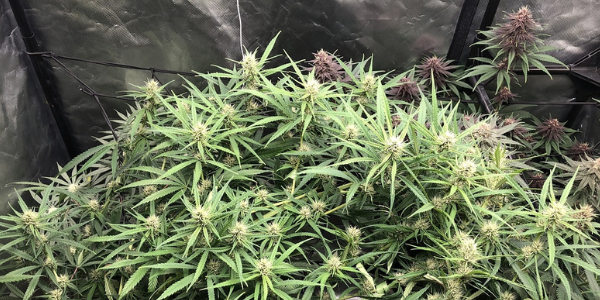
Higher yields
Manifolding is one of the most consistent ways of getting increased yields from your cannabis plants.
It encourages vigorous vegetative growth and increases the number of bud sites on your plants through a clear step-by-step process that only involves topping and training.
You can expect to get at least 40% more from harvesting manifolded plants than you would regularly-grown cannabis.
It also helps that manifolding isn’t as risky as some people make it out to be despite being a high-stress training technique.
So long as you follow the step-by-step process correctly and choose the right strain to manifold, you won’t see any losses.

Simplicity
Compared to other plant training methods, manifolding is simple. It consists of repeating two steps – topping and training.
Topping is easy enough; it involves removing the apical bud of your plants to encourage the lateral growth of its branches.
You can learn more about this pruning technique by reading our article about topping marijuana.
Meanwhile, training your plants means encouraging them to grow in a certain way.
In the case of manifolding, it’s making sure that your main stems grow outwards rather than upwards.
These two steps are simple because there are no ‘judgment calls’ on how and when to do them.
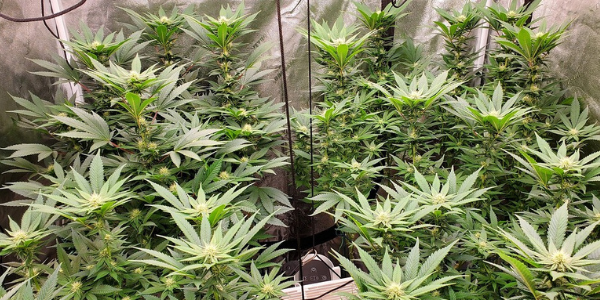
Better ventilation
One of the other benefits of manifolding is that it helps provide better airflow for your plants, which is vital for your cannabis, especially its buds.
Having better-ventilated plants avoids mold and other fungal infestations from tainting your harvests.
Marijuana diseases like bud rot are also less likely to appear on your plants.
Additionally, manifolded plants are less susceptible to mold during the drying and curing process because they would have less plant material to dry, and the buds dry more evenly.
Manifolding makes the post-harvest process safer, easier, and faster.
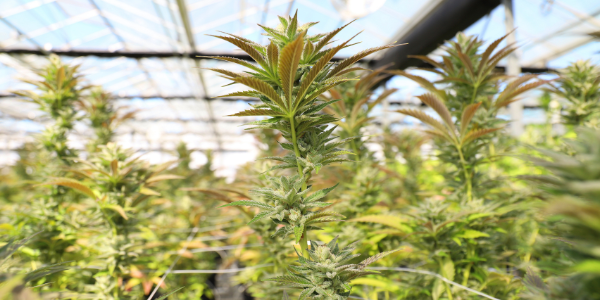
Easier harvest
Speaking of, cannabis manifolding makes the entire harvest easier.
While growing manifolded cannabis, you would also follow the instructions for easy harvesting.
Remember, part of the necessary steps in manifolding cannabis is pruning and defoliating.
By the time you harvest your cannabis plants, you won’t have difficulty trimming them since there won’t be a lot of foliage to remove.
By exerting yourself throughout the entire growing process, through pruning and defoliating your plants, you save yourself from the arduous task of trimming your buds.
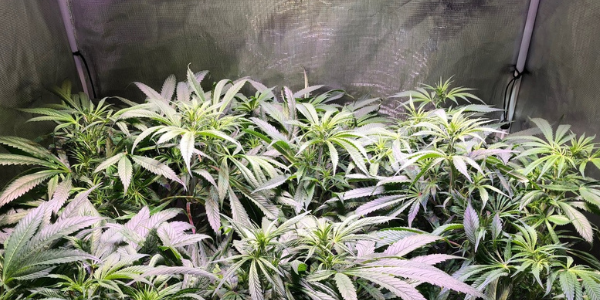
What are the disadvantages of manifolding
All high-stress plant training has one thing in common. The first is that they tend to extend the grow time of your plants by adding a week or two.
Your cannabis needs time to recover, which means extending the vegetative stage of the plants by either keeping them under a 16/8 hours of light and darkness or by choosing a strain that has a longer vegging period.
Besides extending the growing time of your plants, manifolding is time-consuming and, at times, tedious.
You would need to top and train your plants throughout the growing process and prune any unnecessary foliage.
It may not seem much at first, but keep in mind that there are other tasks involved when growing cannabis.
The last caveat of manifolding is that it causes stress – like all types of plant training methods involving pruning.
Of course, this stress is good since it serves as a way to push your plants to grow more vigorously as a response to said stress.
However, this could potentially backfire on you if you choose to manifold plants that either can’t handle too much stress or plants that are weak after an incident (either recovering from infestation or disease).
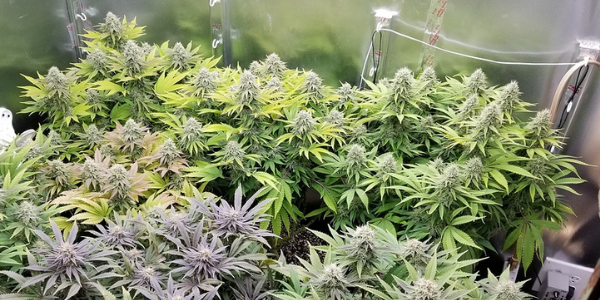
Conclusion
Manifolding is a high-stress plant training technique that helps increase the yield of your cannabis plants.
It’s one of the few plant training methods you can apply on autoflowers t(as long as you choose the right strain).
However, choosing the best strain for manifolding shouldn’t just be when attempting to try it on autoflowers.
You should consider the strain whenever you plan to grow plants that you will train and only select the highest quality genetics. (I sell some if you need them.)
If you want to learn more about manifolding and other plant training techniques that can help increase your plants’ yields and health, download my Grow Bible to start growing like a pro.
Happy Growing
Robert Bergman
FAQ’s about Manifolding
It is. Manifolding has clear instructions to follow and doesn’t involve making any judgment based on feel and experience. However, if you are a beginner, you should consider low-stress training (LST) before trying manifolding. It will help give you the experience you need since manifolding is sometimes considered an LST.
The best technique to pair for manifolding is lollipopping. It’s one of the last steps you need to do before harvest.
The basis of manifolding, a technique that increases the number of colas on your cannabis plants, is topping. Topping is a pruning method that encourages the growth of multiple main stems on a single plant. By having numerous main stems, you, in turn, have multiple colas.
The post Manifolding appeared first on I Love Growing Marijuana.
